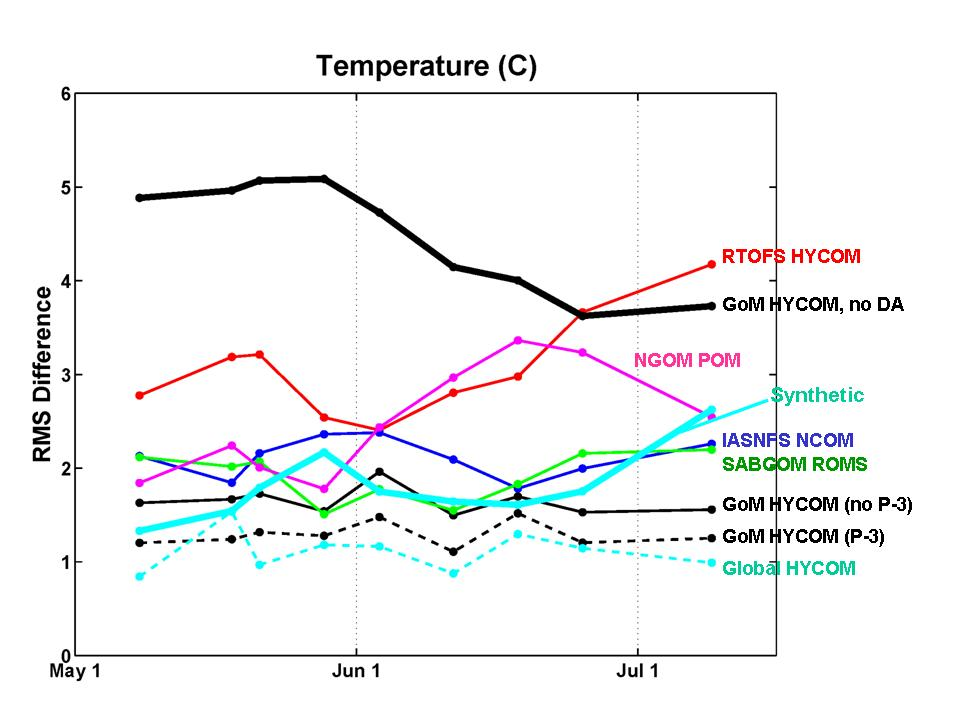Modeling and Observing System Design Studies for the Gulf of America
PIs: George Halliwell (NOAA/AOML/PhOD)
External PIs: Vassiliki Kourafalou (UM/RSMAS), and Ashwanth Srinivasan (UM/RSMAS)
Collaborators: Gustavo Goni (NOAA/AOML/PhOD)
The overarching goal of this project is to improve ocean analyses used to initialize standalone ocean models for ocean forecasting in emergencies such as oil trajectory forcing and search and rescue, and to initialize coupled ocean-atmosphere models for hurricane forecasting. The Deepwater Horizon oil spill exposed significant weaknesses in available ocean model analyses as summarized in Figure 1.
This project uses two approaches: First, four state-of-the-art data assimilation (DA) techniques are being evaluated in the HYbrid Coordinate Ocean Model (HYCOM) at AOML to identify the optimum choice and to improve the performance of the DA system through procedural improvements such as optimizing details of the update cycle. Second, Observing System Experiments (OSEs) and Observing System Simulation Experiments (OSSEs) are used to evaluate existing and new observing systems, respectively.
The OSE/OSSE system uses the AOML HYCOM DA system, and initial OSSEs will be run using a fraternal twin system where two substantially different configurations of HYCOM are used for the nature run and operational DA models. The HYCOM DA system will be evaluated versus all available observations from AOML and outside sources, and will also be evaluated against the performance of other DA systems. Ocean analyses generated using the HYCOM DA system will be used in retrospective studies of the Deepwater Horizon oil spill in collaboration with observational oceanographers at AOML.

Figure 1. RMS errors of temperature from 30 to 360 m between profiles measured by a NOAA WP-3D hurricane research aircraft on 9 flight days during the DWH oil spill and profiles extracted from several numerical models plus synthetic profiles derived from satellite altimetry at AOML (thick cyan line). The thick black line is for a HYCOM run without DA and shows large errors as expected. All other models used DA, but differ in the DA method and observations selected for assimilation. In general, the Navy HYCOM system performed well compared to other models as shown by the thin solid and dashed black lines plus the dashed cyan line, but there is still room for further improvement. The new AOML HYCOM DA system will be evaluated against these and possible other models.
Publications
Mariano, A. J., V. H. Kourafalou, A. Srinivasan, H. Kang, G. R. Halliwell, E. H. Ryan, and M. Roffer, 2011. On the modeling of the 2010 Gulf of Mexico oil spill. Dyn. Atmos. Oceans, In-press.
Shay, L. K., B. Jaimes, J. K. Brewster, P. Meyers, E. Claire McCaskill, E. Uhlhorn, F. Marks, G. R. Halliwell, Jr., O-M Smedstad, and P. Hogan, 2011. Airborne ocean surveys of the Loop Current complex from NOAA WP-3D in support of the Deep Water Horizon oil spill. In Monitoring and Modeling the Deepwater Horizon Oil Spill: A Record-Breaking Enterprise, Liu et al., Eds., AGU. Monograph Series, In-press.